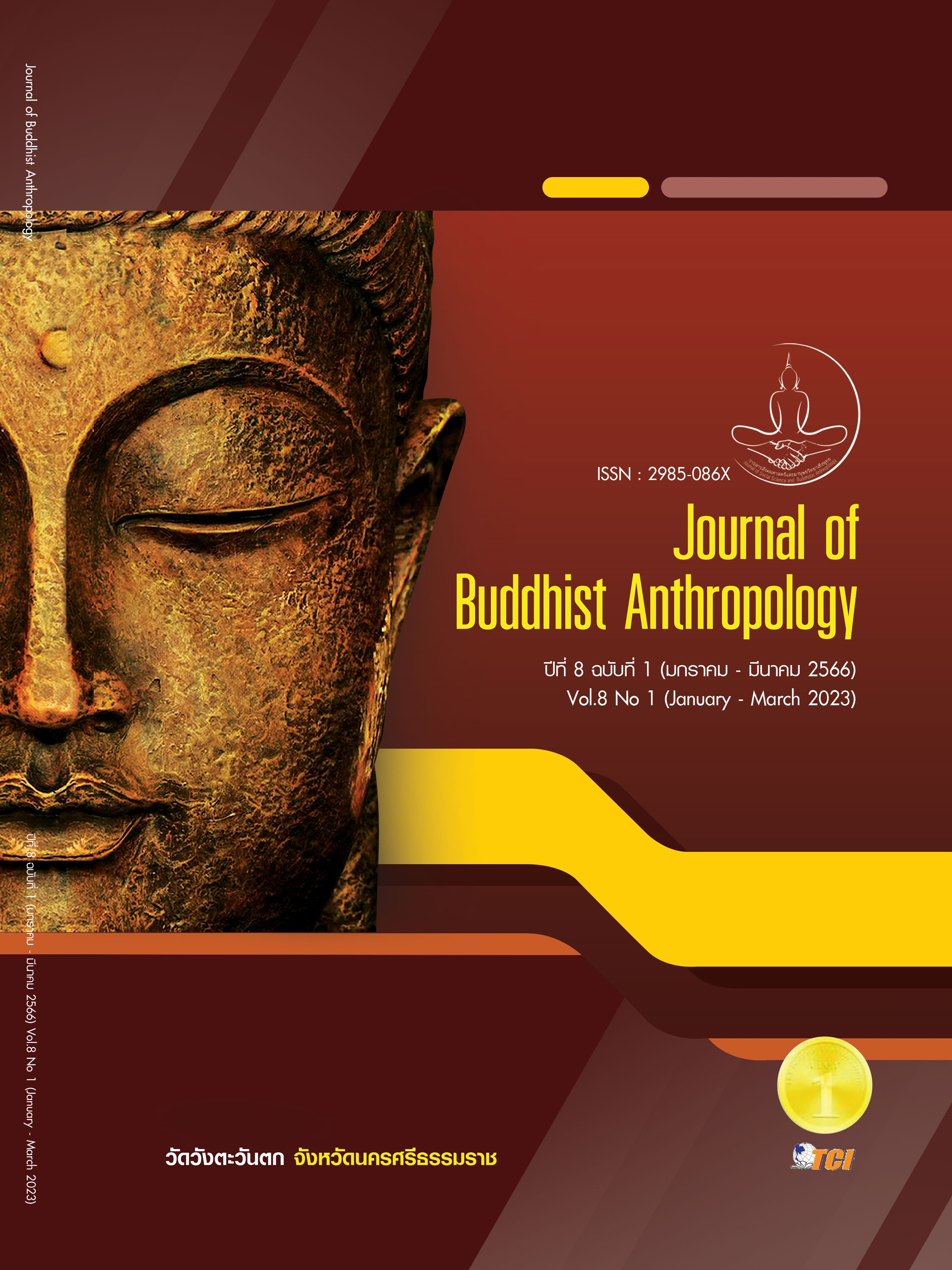AN APPLICATION OF SAPPAYA 4 IN HAPPINESS COMMUNITY DEVELOPMENT OF BAN NONG RANG COMMUNITY, BANG RUP SUB-DISTRICT, THUNG YAI DISTRICT, NAKHON SI THAMMARAT PROVINCE
Keywords:
An Application, Sappaya 4, Development, Happiness CommunityAbstract
Background and Objectives: Community management that can produce livelihood and happiness is essential. Community leaders must set an example for keeping the community area clean, orderly, and shady for visitors. Exclusively, the temple in the community must be the center of the mind of the community. The temple area should be arranged in proportion so that it can be beneficial for oneself, family, community, and society. The purposes of this article were: 1) To study the environment of Ban Nong Rang community, Bang Rup Sub-district, Thung Yai district, Nakhon Si Thammarat Province; 2) To study the Sappaya 4 principle in Theravada Buddhism; 3) To apply the Sappaya 4 principle in development of the happiness community in Ban Nong Rang community, Bang Rup Sub-district, Thung Yai District, Nakhon Si Thammarat Province.
Methodology: The study employed a qualitative research method. Key informants include religious experts, government agencies, community leaders, and people in the area. Twenty-five persons were selected in total by the purposive sampling method. Research tools include structured in-depth interviews, Information collected from relevant documents, and in-depth interviews.
Main Results: The research results indicate that: 1) The environment of Ban Nong Rang community should adhere to the principles of Buddhism as a guideline to build and improve body, mind, discipline, and wisdom for solving problems caused by human selfishness in basis; 2) The Sappaya 4 Principles that appear in Theravada Buddhist scriptures is a general natural principle that influences the well-being of a person whether in decline or prosperity, if a person lives in a good environment that person will prosper and getting things that "comfortable in Dharma" (sappaya) will promote one's life to live according to the teachings of the Buddha to develop the body and mind; 3) The application of the Sappaya 4 principle in the development of the happiness community in Ban Nong Rang community, Bang Rup Sub-district, Thung Yai District, Nakhon Si Thammarat Province. The Sappaya 4 principle should be used in developing people to prosper physically and mentally to make their life full of purpose and value. The Sappaya 4 principle also makes people live their life with sustainable happiness for themselves, their community, and their society.
Involvement to Buddhadhamma: The application of the Sappaya 4 principle in the development of the community in Ban Nong Rang is related to Applied Buddhism, indicating that when the Sappaya 4 principle is applied to the community, it makes people in the community delighted both in body and mind. Happiness can prosper when there is a suitable place for everyday life. Happiness can prosper when there are monks who lead the community and give advice and knowledge in various fields. Happiness can prosper when there are foods that are beneficial to the body. Happiness can prosper when there are teachings for the basis of living and creating happiness for people and their family.
Conclusions: The application of the Sappaya 4 principles in community development can create happiness and religious places, residential houses, as well as public areas in the community to be nice, shady, clean, and not crowded. When people in the community are in the right places, they will receive food that is hygienic and clean then they live with a healthy body with good mental health, they become generous and help each other, creating love, unity, and most importantly, people in the community will live in the teachings of Buddhism and make a peaceful community.
References
Cronbach, L. J. (1990). Essentials of psychological testing (5th ed.). Harper Collins Publishers.
Dulyakasem, U. & Ngamwittayapong, A. (1997). Images of education and community: Conceptual framework and research proposal. The Thailand Research Fund.
Khuras, P. (2018). Integrating Dharma Principles for Community Development in Thai Society to be Strong. ARU Research Journal Humanities and Social Sciences. 5(3), 113-122.
Mahattanadul, S. (2014). Buddhist Biology: Systemic Relationship of Life and Environment, and the Creation of Supportive Factors for Development of Life Based on the Seven Suitable (Sappaya). [Research Report, Mahachulalongkornrajavidyalaya University]. Buddhist Research Institute Central Library. Mahachulalongkornrajavidyalaya University. https://lib-opac.mcu.ac.th/cgi-in/koha/opacdetail.pl?biblionumber=200958&query_desc=kw%2Cwrdl%3A%20%สานุ%20%มหัทธนาดุลย์.
Phra Likit Dinnapanñño. (2017). The Management Model of Suitable Things in Dhamma Practice School Northeast Region Thailand. Journal of Graduate Studies Revi Mahachulalongkornrajavidyalaya University. 13(special issue 3), 34-45.
Phramaha Suthit Apakaro, Phrakhru Vimaladhammarangsi & Phoowachanathipong, K. (2015).The creating and developing Buddhist happiness indicators according to the Buddha's principle of teacheing. [Research Report, Mahachulalongkornrajavidyalaya University]. Buddhist Research Institute Central Library. Mahachulalongkornrajavidyalaya University. https://lib-opac.mcu.ac.th/cgi-bin/koha/opacdetail.pl?biblionumber=149703&query_desc=kw%2Cwrdl%3A%20The%20creating%20and%20developing%20Buddhist%20happiness%20 indicators%20according%20to%20the%20Buddha%E2%80%99s%20principle%20of%20teaching.
Tansakul, W. (2019). Guidelines for creating community happiness. Health Service Support Division.
Downloads
Published
How to Cite
Issue
Section
License
Copyright (c) 2023 Journal of Social Science and Buddhistic Anthropology

This work is licensed under a Creative Commons Attribution-NonCommercial-NoDerivatives 4.0 International License.








